The Run Options tab includes the following pages to help you configure how the Application object runs on the workstation:
The Application property page, shown below, determines general options to be used by Application Launcher/Explorer when running the application on a workstation.
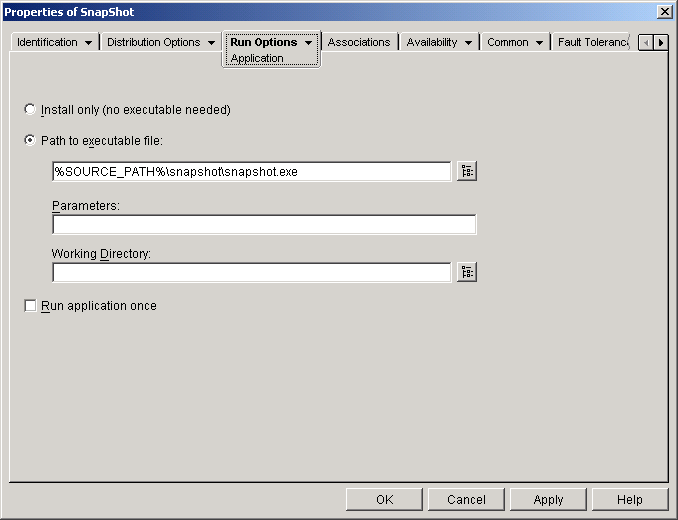
Check this option if the Application object does not include an application executable that Application Launcher/Explorer should run after distributing the Application object. For example, you would want to use this option if the Application object's only purpose is to update some files on the workstation, such as a driver or font, or to make modifications to some workstation settings, such as the registry settings.
Enter, or browse for, the path to the executable that Application Launcher/Explorer will run after the application is distributed. Typically, this path is defined when you create the Application object and should already contain the path to where the executable is located on the network or where it will be located on the user's workstation after distribution.
The following path syntaxes are valid:
You can also use macros in this field. For information about macros, see Macros .
Specify any command line parameters that need to be passed to the executable specified in the Path to Executable File field. See your Windows documentation for more information. The field limit is 250 characters.
You can also use macros in this field. For information about macros, see Macros .
Specify the working directory of the executable you specified in the Path to Executable File field. Typically, this is the directory in which the executable file is located. However, if another directory contains additional files required by the application to run, specify that directory. See your Windows documentation for more information.
The following path syntaxes are valid:
You can also use macros in this field. For information about macros, see Macros .
Check this option to have Application Launcher/Explorer run the application one time only and then remove the Application object's icon from the workstation. If the Application object's version number (Distribution Options > Options page) changes, the Application object icon will appear again so that the new version can be distributed.
This option can be useful when an Application object's only purpose is to install software to a workstation. Having the Application object's icon remain after the application has been installed can be confusing to users, especially if you have an application shortcut or program group icon created during the distribution (see the Distribution Options > Icons/Shortcuts page).
This option can also be used in combination with other Application object settings. For example, if the application is specified as Force Run on the Associations page (meaning that without any user involvement, the application will run when it becomes available to Application Launcher/Explorer), the application is forced to run only one time.
The Environment property page, shown below, specifies the workstation environment that Application Launcher/Explorer will create before running the application on the workstation.
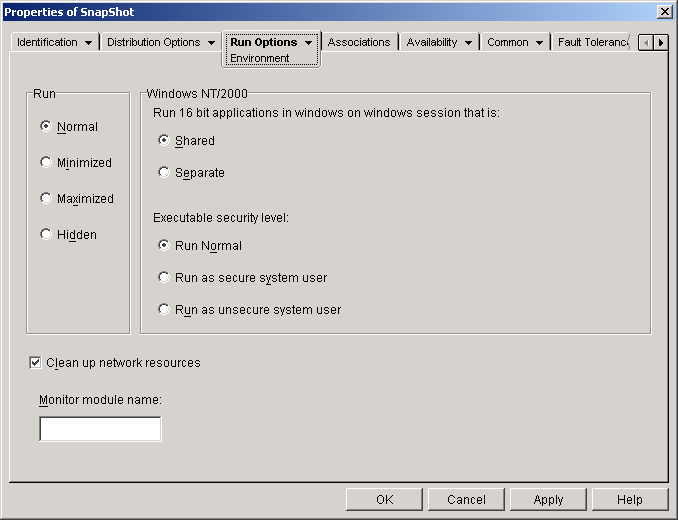
Select the application's initial window size: Normal, Minimized, Maximized, or Hidden. In Hidden mode, the application will run normally without a user interface available. This is useful if you want the application to process something then go away without user intervention. For example, you could use it for the Remote Control agent if you don't want it to appear in the taskbar.
Use these options to specify how applications run on Windows NT/2000/XP workstations.
If you are setting up a 16-bit application to run on Windows NT/2000/XP, specify either a shared or separate Windows on Windows (WOW) session. To run on Windows NT/2000/XP, 16-bit applications must run in a Virtual DOS Machine (VDM) that emulates Windows 3.1 functionality. 16-bit Windows applications can run in their own separate WOW sessions or they can share a WOW session with other 16-bit applications. Sharing a WOW session saves memory and allows applications to use DDE or OLE to communicate with other applications in the same WOW session. Running an application in its own separate WOW session allows for more robust operation because the application is isolated from other 16-bit applications. Because some applications do not run properly in a separate WOW session, the default option is to run the 16-bit Windows application in a shared WOW session.
Select one of the following security levels for the application:
Run Normal: The application inherits the logged-in user's credentials. For example, the application has the same rights to the registry and the file system as the logged-in user.
Run As Secure System User: Running under the System user, the application inherits the workstation's credentials and is run as a Windows NT/2000/XP process. For example, the application has full rights to the registry and the file system. Because the security level is set to Secure, the application's interface is not displayed to the user and the application is only visible in the Task Manager. This option is useful when distributing applications that require full access to the workstation but require no user intervention, such as a service pack or update.
Run as Unsecure System User: This option is the same as Run As Secure System User, with the exception that the application's interface is displayed to the user. This means that the application can display dialog boxes and prompt the user for information if necessary. In return, the user will have the ability to do whatever that application offers on the workstation. For example, if you specify REGEDIT as an unsecure system user, the workstation's user will able to edit any registry values.
On a Windows 2000 Advanced Server functioning as a Windows terminal server, applications that run as Secure System User or Unsecure System User are displayed on the server's console and not in the user's terminal session. This occurs because the Application Launcher/Explorer Service for Windows NT/2000/XP, which launches and runs the application, is running as a console user, not as a terminal server user.
Check this option to remove network connections, drive mappings, and port captures that were established for running the application. If this option is not selected, the network resources remain in effect. If the resource is already in use when Application Launcher/Explorer starts the application, it is not cleaned up until all other distributed applications are finished using it. If distributed applications are still running when Application Launcher/Explorer is terminated, the allocated resources remain intact.
When an application is launched, Application Launcher/Explorer monitors the executable of the application. When the executable terminates, the process of cleaning up network resources begins. However, it's possible that the executable filename is actually a "wrapper" that sets up environments, runs other executables, and then terminates. If Application Launcher/Explorer monitors the wrapper executable, it might prematurely start cleaning up network resources before the application has terminated. Consult your application documentation about whether the application uses a wrapper executable. If it does, find out the name of the module that remains running. Type this name (without the extension) in the text box provided.
The Launch Scripts property page, shown below, defines the scripts Application Launcher/Explorer will execute when running the application.
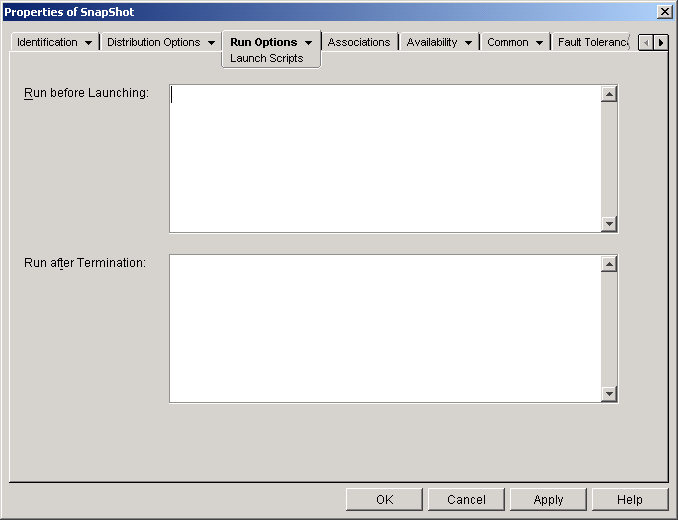
The scripts support the same commands and syntax as the Novell Client, with the exception of the ones listed below. For script commands, syntax, and examples, see the Novell Client documentation on the Novell Documentation Web site.
Application Launcher/Explorer will not output anything to the screen, display errors, or support the following commands:
Use this text window to enter any script commands you want Application Launcher/Explorer to execute before launching the application. The script is executed in the order shown below:
Use this text window to enter any script commands you want Application Launcher/Explorer to execute after the user closes the application. The script is executed in the order shown below:
IMPORTANT: The Run After Termination script is executed before the network resources are cleaned up (Run Options > Environment page). However, the Clean Up Network Resources option will not clean up drive mappings or port captures created by the Run Before Launching script. To clean up these resources, enter the appropriate commands in the Run After Termination script.
The Environment Variables property page, shown below, specifies the environment variables that Application Launcher/Explorer will set before running the application. For example, you can specify the application's working directory in the PATH environment variable.
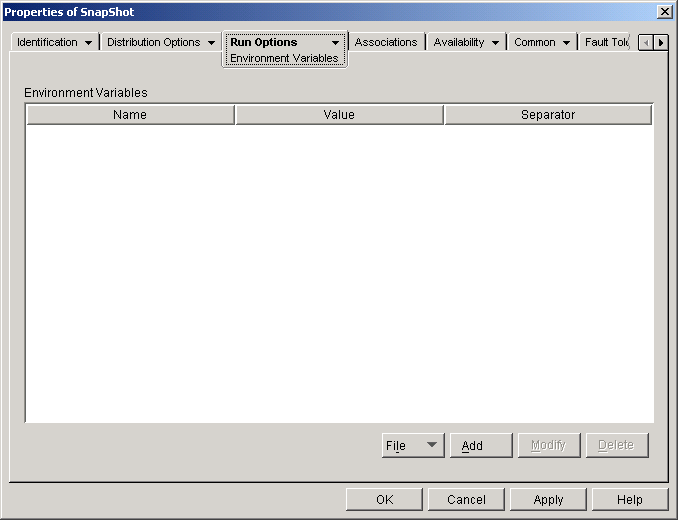
The Environment Variables list displays all variables that will be modified before the application is run. Application Launcher/Explorer modifies only the variables in this list.
Click File > Find to search for variables or variable data in the Environment Variables list.
Click File > Import to import variables from another Application object's .AOT or .AXT file.
To add a variable to the Environment Variables list, click Add to display the Edit Environment Variables dialog box > enter the variable name and data > check Append to Existing Data Using Separator Character (only if you want to append the data to the workstation's existing variable) and enter a separator character > click OK.
In the Environment Variables list, select the variable you want to modify > click Modify.
In the Environment Variables list, select the variable you want to delete > click Delete to remove it from the list.
The License/Metering property page, shown below, configures Application Launcher/Explorer to use Novell Licensing Services (NLS) to track application usage and comply with the application's licensing agreement. NLS must already be installed, and you must have created a License Container and a Metered Certificate for the application. For detailed information about setting up license metering, see Metering Software Licenses .
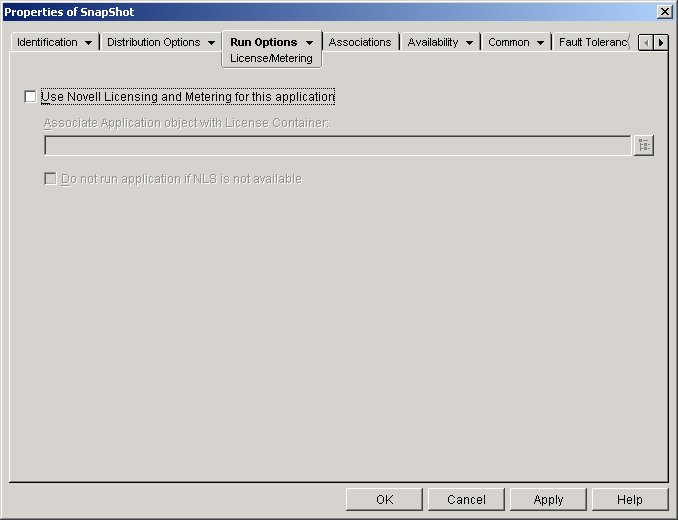
Check this option to enable metering of the application.
Once metering is enabled, select the License Container in which you've created the application's Metered Certificate.
Check this option to prevent users from running the application if NLS is not running.